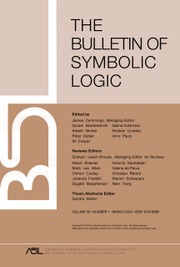Crossref Citations
This article has been cited by the following publications. This list is generated based on data provided by Crossref.
Yokoyama, Keita
2007.
Non‐standard analysis in ACA0 and Riemann mapping theorem.
Mathematical Logic Quarterly,
Vol. 53,
Issue. 2,
p.
132.
Fleischer, Rudolf
2007.
Fun with Algorithms.
Vol. 4475,
Issue. ,
p.
146.
Fleischer, Rudolf
2009.
Die Another Day.
Theory of Computing Systems,
Vol. 44,
Issue. 2,
p.
205.
Shore, Richard A.
2010.
Reverse Mathematics: The Playground of Logic.
The Bulletin of Symbolic Logic,
Vol. 16,
Issue. 3,
p.
378.
Jerome Keisler, H.
2010.
Nonstandard arithmetic and recursive comprehension.
Annals of Pure and Applied Logic,
Vol. 161,
Issue. 8,
p.
1047.
Yokoyama, Keita
2010.
Formalizing non-standard arguments in second-order arithmetic.
The Journal of Symbolic Logic,
Vol. 75,
Issue. 4,
p.
1199.
Sanders, Sam
2010.
Relative arithmetic.
Mathematical Logic Quarterly,
Vol. 56,
Issue. 6,
p.
564.
Sanders, Sam
2011.
ERNA and Friedman's Reverse Mathematics.
The Journal of Symbolic Logic,
Vol. 76,
Issue. 2,
p.
637.
Simpson, Stephen G.
and
Yokoyama, Keita
2011.
A Nonstandard Counterpart of WWKL.
Notre Dame Journal of Formal Logic,
Vol. 52,
Issue. 3,
Rathjen, Michael
2011.
2010 European Summer Meeting of the Association for Symbolic Logic. Logic Colloquium '10.
The Bulletin of Symbolic Logic,
Vol. 17,
Issue. 2,
p.
272.
KREUZER, ALEXANDER P.
2012.
NON-PRINCIPAL ULTRAFILTERS, PROGRAM EXTRACTION AND HIGHER-ORDER REVERSE MATHEMATICS.
Journal of Mathematical Logic,
Vol. 12,
Issue. 01,
p.
1250002.
Sanders, Sam
2013.
New Challenges to Philosophy of Science.
p.
99.
Sanders, Sam
2014.
Algorithm and proof as Ω-invariance and transfer: A new model of computation in nonstandard analysis.
Electronic Proceedings in Theoretical Computer Science,
Vol. 143,
Issue. ,
p.
97.
Horihata, Yoshihiro
and
Yokoyama, Keita
2014.
Nonstandard second-order arithmetic and Riemannʼs mapping theorem.
Annals of Pure and Applied Logic,
Vol. 165,
Issue. 2,
p.
520.
Sanders, Sam
2018.
Logical Foundations of Computer Science.
Vol. 10703,
Issue. ,
p.
309.
Sanders, Sam
2018.
Sailing Routes in the World of Computation.
Vol. 10936,
Issue. ,
p.
365.
Avigad, Jeremy
2018.
Introduction to Formal Philosophy.
p.
177.
Normann, Dag
and
Sanders, Sam
2019.
The strength of compactness in Computability Theory and Nonstandard Analysis.
Annals of Pure and Applied Logic,
Vol. 170,
Issue. 11,
p.
102710.
van den Berg, Benno
and
Sanders, Sam
2019.
Reverse Mathematics and parameter-free Transfer.
Annals of Pure and Applied Logic,
Vol. 170,
Issue. 3,
p.
273.
Hrbacek, Karel
and
Katz, Mikhail G.
2021.
Infinitesimal analysis without the Axiom of Choice.
Annals of Pure and Applied Logic,
Vol. 172,
Issue. 6,
p.
102959.

